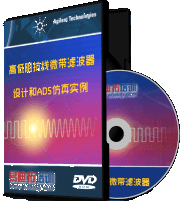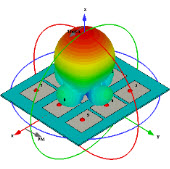CST2009如何实现3D模型和电路联合仿真
提示你什么错误?
我也是刚刚接触CST不久,我觉得我的问题可能是3D的S参数计算完后并没有导入到电路的那个窗口。然后我在电路窗口建立一个新的S参数仿真任务,其实我真的没有找到运行仿真的开始按钮,然后我就让它执行网络参数提取那个运行,提示错误是说我的那个模型的S没有计算,呵呵,我有些混乱,麻烦您给出一个步骤,我先模仿一下,呵呵!
看看CST design STUDIO教程,里面能够给你问题的答案,实现电路和场协调仿真。
有人告诉我用得到的S数据表在ADS中生成一个四端口元件,然后再在ADS中仿真,这个我也没实现过,打算也实现一下,可是我觉得CST这么强大的软件,这么小的问题它自己就应该能解决的,所以上来向高手请教一下!
哦,先谢谢了!
现在CST Design Studio已经集成到所有的CST Suite组件里,所以你在Microwave Studio里面仿真得到的结果是可以直接在Design Studio里面使用的,不存在“导入”这个概念。
Design Studio的运行快捷键就在上面的快捷按钮栏上,只要新建一个仿真任务就可以运行。这里小编的描述比较不清楚:“其实我真的没有找到运行仿真的开始按钮,然后我就让它执行网络参数提取那个运行”。没有找到开始按钮,那你是怎么让它开始执行的?什么叫做“执行网络参数”?“提取运行”又是什么意思?
关于ADS的仿真,小编是指在ADS里仿真没实现还是指将S参数导出成为Touchstone文件(S4P)没有实现?
关于联合仿真的步骤,只要看看CST Suite的帮助文件、Tutorial、Example和Application Notes,有非常多的相关信息你都可以参考。
恩,对,昨晚跑了一下,结果不是很理想,联合仿真结果与单独用ADS仿真的结果相差很多,主要是3D模型四端口的S参数就与ADS的S参数有很大差别。输入和输出的1,2端口用波端口应该没问题吧。3,4离散端口定义的长度有什么意义呢?比如我要在3端口之间(两个不同导体之间)加一个电容要如何定义这个端口呢,就是形成3,3’之间加电容
Design Studio用得不多,所以不清楚这个该怎么设置。看看有没有高人可以回答你。
再请问小编,仿真时状态消息栏中出现的 Warnning: the shape "*" cannot be correctly processed by ACIS............这里的ACIS是什么意思啊 ?
还有 29 mesh cells are represented in staircase mode and have been filled with PEC.这个警告是什么意思啊?可以用专家系统生成的网格来解决掉吗?
Did you import the model file from another CAD software?
The 3D ACIS Modeler (ACIS) is a 3D modelling kernel (or engine) owned by Spatial Corporation (formerly Spatial Technology). ACIS is used by many software developers industries such as computer-aided design, (CAD), Computer-aided manufacturing (CAM), Computer-aided engineering (CAE), Architecture, engineering and construction (AEC), Coordinate-measuring machine (CMM), 3D animation, and shipbuilding. ACIS provides software developers and manufacturers the underlying 3D modeling functionality. ACIS features an open, object-oriented C++ architecture that enables robust, 3D modelling capabilities. ACIS is used to construct applications with hybrid modeling features, since it integrates wireframe model, surface, and solid modeling functionality with both manifold and non-manifold topology, and a rich set of geometric operations. http://en.wikipedia.org/wiki/ACIS
Help can answer your staircase mesh question:
1. Staircase mesh: Use the classic finite difference staircase scheme for surface bodies or imported shapes that produce errors during the matrix generation.
2. Staircase mesh: In addition to the PBA mesh, a classic staircase mesh is provided. Choose the staircase mesh for imported structures that are not solids or that cannot be healed.
3. Staircase mesh: The classic hexahedral staircase meshing is extremely robust and recommended if the other mesh type methods fail due to unremovable errors of imported surface bodies or shapes.
4. To simulate a surface structure or an imported shape that cannot be healed, select the appropriate object in the navigation tree and choose the Staircase Mesh option as the meshing type in the Edit Local Mesh Properties dialog. In contrast to PBA mesh, this classic finite difference scheme allows only one material in a mesh cell. If the shape consists of PEC material, a thin sheet mesh is used. For a non-PEC material, the surface is represented by staircase mesh cells.
5. For corrupted import data, where the healing algorithm failed, or for very large and complex CAD imports, switching to the standard staircase mesh might be helpful.
Then, the expert system.
In default, CST generate mesh by using expert system already, unless you manually turn off the "Automatic mesh generation" in Global mesh properties.
thank you!
网格划分不够,建议加密网格。
场仿真时间比较长,而且优化时间非常长。建议不要动不动就建全模型放进CST里面仿真,分模块设计,可以用路的方法分析尽量用路的方法来做,尽管有差异,但是差异比较小也就可以了。
最佳的方式应该多用几个软件,每个软件多有优势。结合不同软件的优势,可以大大的提高工作效率。比如说在CST里面仿真导出3D仿真的S参数模型,然后再导出S4P文件,再把S4P文件导入到微波办公室或者是ADS,采用路的方式可以很方面优化,而且速度特块,精度还可以。
最后把初步的参数确定后再在CST里面建模,优化,因为初步尺寸确定好,不需要太多优化次数便能较好的收敛与目标值。
这是我的一点建议,希望能够对小编有用。
小编我跟你要建立的模型基本上是一样的,不过我只会画出三个电感,不知道怎么加电容啊,希望你能帮帮忙谢谢。我的QQ:551821490
恩,有道理啊!谢谢啊
这个我也是在摸索,我现在是这样弄的,电感弄好后,有四个端口,两个为输入输出波端口,另外两个为离散端口,这样这个模型对应的DS窗口的模型就有四个端口和它对应了,然后你就接上外端口和电容。我是这样搞的,但是我没优化前的S11很不好,我不知道怎样能联合优化,就像llj85讲的仿真很慢,很崩溃,我倒是也想和你交流一下,你的电感建模的时候有没有遇到这个问题,就是电感线圈始端和末端要有转角,我旋转完的时候不能够把他们合并到一起,老提示有错误:ACIS error in boolean operation(span info missing for ef_int construction),这个错误倒是能用复制第一个转角的方法解决,但是把复制的那个转角移动到另一段的时候连接的不紧密,有小缺口。CST建的螺旋电感模型接头越多偏差越大,不知道有高手能不能解决这个问题。
在CST里面仿真导出3D仿真的S参数模型,然后再导出S4P文件,再把S4P文件导入到ADS,弱弱的问,具体如何操作呢?呵呵,应该是用import吧,现在正在用ADS-co simulation
你是指从CST导出S4P还是在ADS里添加四端口网络?
不管怎么导,端口阻抗的一致性很重要。
相关文章:
- CST模型导出的问题 (05-08)
- 求,波导式微波功率分配器设计模型 (05-08)
- 求助!哪位大哥有FSS的仿真模型啊? (05-08)
- 等离子体模型的建立 (05-08)
- CST导出结构模型时遇到的问题? (05-08)
- 新手如何把HFSS模型导入CST (05-08)











